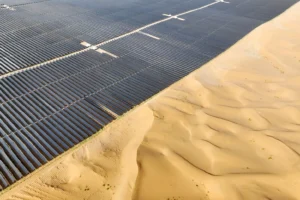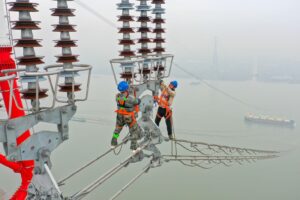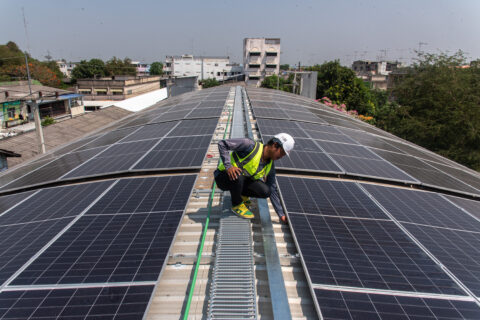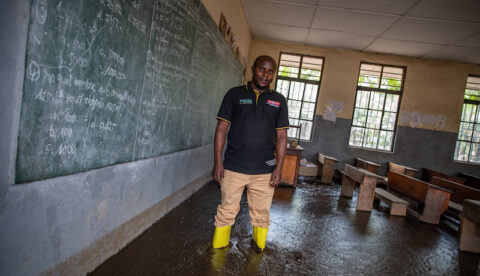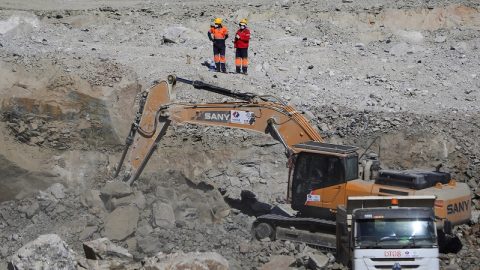Last year was significant for energy and climate developments in China. Carbon dioxide (CO2) emissions growth hovered close to 2023 levels throughout the year, raising the possibility of China’s CO2 emissions peaking before 2030.
China’s renewable energy buildout pushed coal to a record low share of electricity generation, while steps were taken to expand the number of industries covered by the national carbon market.
On the global stage, China played a prominent role at the COP29 UN climate talks in Baku, Azerbaijan. However, the US-China alignment that had previously boosted global climate ambition was imperiled by growing tensions over trade.
With US influence in climate negotiations expected to wane under the incoming Trump administration, China’s statements on climate ambition – such as the international climate pledge it is due to publish in 2025 – will be an important determinant of the pace of decarbonisation, both domestically and internationally.
Carbon Brief asked nine leading experts what they are watching for from China over the year ahead. Their responses have been edited for length and clarity.
 Dr Muyi Yang
Dr Muyi Yang
Senior electricity policy analyst for China
Ember
In 2025, China will need to strike a delicate balance between sustaining economic growth and advancing its decarbonisation agenda. This balancing act will require more than just scaling up renewables such as wind, solar and energy storage – coal power, which has long been central to China’s energy security and economic activity, also requires a major transformation.
This is not simply about shuttering a handful of coal-fired power plants, but managing the broader tensions and conflicts arising from the decline of the coal-electricity ecosystem. The impacts will extend to power generators, logistics companies, mining firms, equipment manufacturers and the coal-chemical industry, along with the socio-economic systems built around them.
As China approaches a critical turning point – envisioning the start of absolute coal consumption reductions during the next five-year plan period (beginning in 2026) – it must begin planning for this transition now. Successfully navigating this complex process while safeguarding economic stability, ensuring energy security and delivering on climate commitments will be key to China’s success in 2025 and beyond.
 Prof Boqiang Lin
Prof Boqiang Lin
Dean
China Institute for Studies in Energy Policy
In 2025, China’s energy and climate developments will focus on advancing its “dual-carbon” goals through several key initiatives. The deployment of “new energy” will accelerate, with offshore wind power, distributed solar and decentralised wind power seeing significant growth. New wind and solar installations are expected to reach at least 200 gigawatts (GW). [Installations topped 300GW last year.] Nuclear power will be steadily advanced, with operational nuclear capacity projected to reach 65GW by the end of 2025. Efforts to promote the “clean and efficient use” of coal will also progress, with cleaner and more flexible coal power systems continuing to support the significant growth in wind and solar power.
Energy storage technologies and the development of smart grids will expand, facilitating large-scale integration of renewable energy into the grid, while development of virtual power plants and large-scale vehicle-to-grid pilots will enhance grid efficiency and energy interaction. The supporting infrastructure for electric vehicles (EVs) will also receive more attention to support the rapid increase in EV penetration. The carbon market is expected to expand to include more sectors, with carbon prices gradually increasing.
 Zhe Yao
Zhe Yao
Global policy advisor
Greenpeace East Asia
This year will be an important milestone. As the last year of the 14th “five-year” plan period, we will see if China can get back on track to meet its existing energy and carbon intensity targets. China’s climate plan for the next 10 years (its new nationally determined contribution), will be released and its ambition will be tested.
It is also a year in which we may confirm a structural shift in China’s energy consumption, signifying a peak in emissions. The key indicator of this trend will be whether renewable energy can meet all new electricity demand.
An even tougher test will be whether and how the climate imperative can survive geopolitical challenges. China will have to deal with a new president in the White House and growing competition from the EU in clean industries, so the relationship between China and its conventional climate partners will need to take a new shape. Hopefully, by 2025, a new climate relationship will emerge that is suited to a changing economic and geopolitical context.
 Zhibin Chen
Zhibin Chen
Senior manager for carbon markets and pricing
Adelphi
Looking ahead to 2025, I see several promising aspects of the development of China’s carbon market. These include:
- Significantly expanding the coverage of the national emissions trading scheme (ETS) to officially include the steel, cement and aluminium sectors.
- Starting the issuance, trading and use of China certified emissions reduction (CCER) certificates [in the voluntary carbon market] to meet compliance obligations.
- Transitioning the structure of the national ETS from an intensity-based cap on emissions [per unit of production] to an absolute cap [in tonnes of CO2].
- Allowing traders and investors to participate in China emission allowances (CEA) market trading [within the national ETS].
Of these, the first two points are certain to occur next year and I hope they will be implemented smoothly. The latter two have been mentioned previously by the Ministry of Ecology and Environment policymakers, and I hope the government will establish a concrete timeline and implementation roadmap for them.
 Dr Ilaria Mazzocco
Dr Ilaria Mazzocco
Deputy director and senior fellow with the trustee chair in Chinese business and economics
Center for Strategic & International Studies
What I’m looking out for is how China manages its increasingly tense external commercial relations and the growing demand internationally for Chinese foreign direct investment. Clean technologies, particularly the “new three” of solar, lithium-ion batteries and EVs, are at the heart of this tension.
The brewing global conflict over the future of climate technology manufacturing and trade will depend in no small part on developments in the industries in China, including domestic demand and profitability of Chinese firms. Just as important are the types of trade-offs and deals that China’s trade partners, including the US, will lean towards [in their China policy going forward].
 Kyle Chan
Kyle Chan
Postdoctoral researcher
Princeton University
This will be a pivotal year for Chinese EVs. Fierce competition within China’s domestic market will drive down prices, spur further innovation in features, such as advanced driver-assistance systems, and continue China’s transition from internal combustion engine vehicles (ICEs) to EVs. It will be interesting to see whether emerging trends within China will presage broader global trends, such as the popularity of extended-range [hybrid] EVs and improving battery-swapping technology.
Internationally, Chinese EV and battery makers are expanding to new markets and responding to rising trade barriers by investing heavily in overseas factories from Europe to southeast Asia. One big question is whether these bets will pay off or whether demand for EVs in these markets will be constrained by other factors, such as limited local charging infrastructure. Another big question is to what extent other countries will try to integrate with Chinese EV supply chains – or try to build around them.
 Dr Angel Hsu
Dr Angel Hsu
Associate professor of public policy and environment, ecology and energy
University of North Carolina
I am enthusiastic about the prospects for continued subnational cooperation between China and the US in climate and energy policies, especially following the strong interest shown at COP29. The numerous technical exchanges between states such as Washington and the Chinese delegation…are promising developments. Plans are already in place to sustain this dialogue into 2025, building on the progress made this past year.
I am particularly eager to see how third-party countries and regions can serve as neutral grounds for collaboration. With the US likely stepping back from climate engagement, there’s a significant opportunity for increased alignment between China and ASEAN [the Association of Southeast Asian Nations], for example. China’s proactive approach at COP29, especially regarding voluntary climate financing, positions it well to lead in supporting south-east Asian nations in their decarbonisation efforts, creating a win-win scenario for regional sustainability.
 Shuang Liu
Shuang Liu
China finance director
World Resources Institute
With the “new collective quantified goal” on climate finance set at COP29 in Baku, China could continue its support to developing countries on their low-carbon and resilient transitions through south-south cooperation. Our research shows that China is already a significant climate-finance provider, averaging almost $4.5bn per year between 2013 and 2022.
Data shows China’s climate finance abroad dropped following the pandemic, but has been picking up slowly over the past three years. One big driver of future growth in climate finance could be how China and Chinese stakeholders sustain investment in the clean energy transition in developing countries – with a recent example being deals signed between China and Indonesia on clean energy manufacturing and infrastructure during president Prabowo Subianto’s visit to Beijing in November. Such deals can support the energy transition, create more job opportunities and help achieve other sustainable and development goals in the global south.
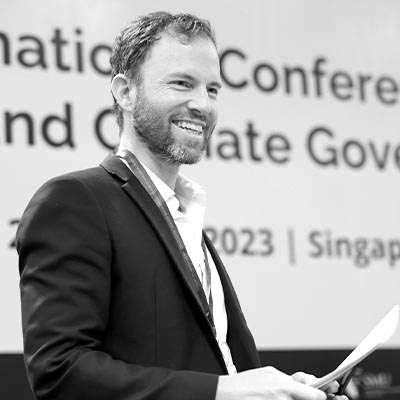 Dr Christoph Nedopil
Dr Christoph Nedopil
Director and professor of economics
Griffith Asia Institute
For 2025, China’s engagement in green energy will likely flourish in the Belt and Road Initiative (BRI), driven by the growing energy transition needs of partner countries. In Indonesia, for instance, president Prabowo’s accelerated green energy plan announced at the G20 meeting in December 2024 and newly signed cooperation agreements with China highlight the role of targeted collaboration [with China] in addressing local energy priorities. This includes investments not only in renewable energy systems, such as solar and wind power, but also in critical technologies such as battery manufacturing to support energy storage and grid stability.
I also hope we can make progress on three challenges: first, how can we simultaneously accelerate investment in green [energy] and phase-down of brown energy (fossil fuels); second, how can local employees benefit more from the green energy transition, particularly with more western trade restrictions on Chinese green tech products; and, third, how can we accelerate greening of industrial and captive energy in the BRI. A particular opportunity for the years ahead lies in sharing lessons from Chinese state-owned enterprises (SOEs) in the power sector to the many other energy SOEs in Asia.
The post Experts: What to expect from China on energy and climate action in 2025? appeared first on Carbon Brief.
Experts: What to expect from China on energy and climate action in 2025?
Climate Change
Colombia proposes expert group to advance talks on minerals agreement
Colombia wants countries to discuss options for a global agreement to ensure that the extraction, processing and recycling of minerals – including those needed for the clean energy transition – don’t harm the environment and human wellbeing.
The mineral-rich nation is proposing to create an expert group to “identify options for international instruments, including global and legally-binding instruments, for coordinated global action on the environmentally sound management of minerals and metals through [their] full lifecyle”.
Colombia hopes this will eventually lead to an agreement on the need for an international treaty to define mandatory rules and standards that would make mineral value chains more transparent and accountable.
The proposal was set out in a draft resolution submitted to the UN Environment Assembly (UNEA) earlier this week and seen by Climate Home News. UNEA, which is constituted of all UN member states, is the world’s top decision-making body for matters relating to the environment. The assembly’s seventh session will meet in Kenya in December to vote on countries’ proposals.
Soaring demand for the minerals used to manufacture clean energy technologies and electric vehicles, as well as in the digital, construction and defence industries have led to growing environmental destruction, human rights violations and social conflict.
Colombia argues there is an “urgent need” to strengthen global cooperation and governance to reduce the risks to people and the planet.
Options for a global minerals agreement
The proposal is among a flurry of initiatives to strength global mineral governance at a time when booming demand is putting pressure on new mining projects.
Colombia, which produces emeralds, gold, platinum and silver for exports, first proposed the idea for a binding international agreement on minerals traceability and accountability on the sidelines of the UN biodiversity talks it hosted in October 2024.
Since then, the South American nation has been quietly trying to drum up support for the idea, especially among African and European nations.
Its draft resolution to UNEA7 contains very few details, leaving it open for countries to discuss what kind of global instrument would be best suited to make mineral supply chains more transparent and sustainable.
Does the world need a global treaty on energy transition minerals?
Colombia says it wants the expert group to build on other UN initiatives, including a UN Panel on Critical Energy Transition Minerals, which set out seven principles to ensure the mining, processing and recycling of energy transition minerals are done responsibly and benefit everyone.
The group would include technical experts and representatives from international and regional conventions, major country groupings as well as relevant stakeholders.
It would examine the feasibility and effectiveness of different options for a global agreement, consider their costs and identify measures to support countries to implement what is agreed.
The resolution also calls for one or two meetings for member states to discuss the idea before the UNEA8 session planned in late 2027, when countries would decide on a way forward.
No time to lose for treaty negotiations
Colombia’s efforts to advance global talks on mineral supply chains have been welcomed by resource experts and campaigners. But not everyone agrees on the best strategy to move the discussion forward at a time when multilateralism is coming under attack.
Johanna Sydow, a resource policy expert who heads the international environmental policy division of the Heinrich-Böll Foundation, said she had hoped that the resolution would explicitly call for negotiations to begin on an international minerals treaty.
“Treaty negotiations take a long time. If you don’t even start with it now, it will take even longer. I don’t see how in two or three years it will be easier to come to an agreement,” she told Climate Home.
Despite the geopolitical challenges, “we need joint rules to prevent a huge race to the bottom for [mineral] standards”. That could start with a group of countries coming together and starting to enforce joint standards for mining, processing and recycling minerals, she said.
But any meaningful global agreement on mineral supply chains would require backing from China, the world’s largest processor of minerals, which dominates most of the supply chains. And with Colombia heading for an election in May, it will need all the support it can get to move its proposal forward.
‘Voluntary initiative won’t cut it’
Juliana Peña Niño, Colombia country manager at the Natural Resource Governance Institute, is more optimistic. “Colombia’s leadership towards fairer mineral value chains is a welcome step,” she told Climate Home News.
“At UNEA7, we need an ambitious debate that gives the proposed expert group a clear mandate to advance concrete next steps — not delay decisions — and that puts the voices of those most affected at the centre. One thing is clear: the path forward must ultimately deliver a binding instrument, as yet another voluntary initiative simply won’t cut it,” she said.
More than 50 civil society groups spanning Latin America, Africa and Europe previously described Colombia’s work on the issue as “a chance to build a new global paradigm rooted in environmental integrity, human rights, Indigenous Peoples’ rights, justice and equity”.
“As the energy transition and digitalisation drive demand for minerals, we cannot afford to repeat old extractive models built on asymmetry – we must redefine them,” they wrote in a statement.
Main image: The UN Environment Assembly is hosted in Nairobi, Kenya. (Natalia Mroz/ UN Environment)
The post Colombia proposes expert group to advance talks on minerals agreement appeared first on Climate Home News.
Colombia proposes expert group to advance talks on minerals agreement
Climate Change
California Sanctions Stark Disparities in Pesticide Exposure During Pregnancy
If you’re young, pregnant and Latina, chances are you live near agricultural fields sprayed with higher levels of brain-damaging organophosphate pesticides.
A baby in the womb has few defenses against industrial petrochemicals designed to kill.
California Sanctions Stark Disparities in Pesticide Exposure During Pregnancy
Climate Change
DeBriefed 3 October 2025: UK political gap on climate widens; Fossil-fuelled Typhoon Ragasa; ‘Overshoot’ unknowns
Welcome to Carbon Brief’s DeBriefed.
An essential guide to the week’s key developments relating to climate change.
This week
Shattered climate consensus
FRACKING BAN: UK energy secretary Ed Miliband has announced that the government will bring forward its plans to permanently ban fracking, in a move designed to counter a promise from the hard-right Reform party to restart efforts to introduce the practice, the Guardian said. In the same speech, Miliband said Reform’s plans to scrap clean-energy projects would “betray” young people and future generations, the Press Association reported.
ACT AXE?: Meanwhile, Kemi Badenoch, leader of the Conservatives, pledged to scrap the 2008 Climate Change Act if elected, Bloomberg reported. It noted that the legislation was passed with cross-party support and strengthened by the Conservatives.
‘INSANE’: Badenoch faced a backlash from senior Tory figures, including ex-prime minister Theresa May, who called her pledge a “catastrophic mistake”, said the Financial Times. The newspaper added that the Conservatives were “trailing third in opinion polls”. A wide range of climate scientists also condemned the idea, describing it as “insane”, an “insult” and a “serious regression”.
Around the world
- CLIMATE CRACKDOWN: The US Department of Energy has told employees in the Office of Energy Efficiency and Renewable Energy to avoid using the term “climate change”, according to the Guardian.
- FOREST DELAY: Plans for Brazil’s COP30 flagship initiative, the tropical forests forever fund, are “suffer[ing] delays” as officials remain split on key details, Bloomberg said.
- COP MAY BE ‘SPLIT’: Australia could “split” the hosting of the COP31 climate summit in 2026 under a potential compromise with Turkey, reported the Guardian.
- DIVINE INTERVENTION: Pope Leo XIV has criticised those who minimise the “increasingly evident” impact of global warming in his first major climate speech, BBC News reported.
€44.5 billion
The cost of extreme weather and climate change in the EU in the last four years – two-and-a-half times higher than in the decade to 2019, according to a European Environment Agency report covered by the Financial Times.
Latest climate research
- Fossil-fuelled climate change caused around 36% of Typhoon Ragasa’s direct damage to homes and properties in southern China, according to a rapid impact attribution study | Imperial Grantham Institute – Climate Change and the Environment
- Some 86% of the global population are concerned about climate change, according to a survey of 280,000 people in 142 countries and regions | Climate Policy
- A global shift towards a “planetary health diet” could slash emissions and save tens of thousands of lives each day | EAT-Lancet Commission 2025 report
(For more, see Carbon Brief’s in-depth daily summaries of the top climate news stories on Monday, Tuesday, Wednesday, Thursday and Friday.)
Captured

Clean energy has met 100% of Great Britain’s electricity demand for a record 87 hours this year so far, according to new Carbon Brief analysis. This is up from just 2.5 hours in 2021 and 64.5 hours in all of 2024. The longest stretch of time where 100% of electricity demand was met by clean energy stands at 15 hours, from midnight on 25 May 2025 through to 3pm on 26 May, according to the analysis.
Spotlight
‘Overshoot’ unknowns
As the chances of limiting global warming to 1.5C dwindle, there is increasing focus on the prospects for “overshooting” the Paris Agreement target and then bringing temperatures back down by removing CO2 from the atmosphere.
At the first-ever Overshoot Conference in Laxenburg, Austria, Carbon Brief asks experts about the key unknowns around warming “overshoot”.
Sir Prof Jim Skea
Chair of the Intergovernmental Panel on Climate Change (IPCC) and emeritus professor at Imperial College London’s Centre for Environmental Policy
So there are huge knowledge gaps around overshoot and carbon dioxide removal (CDR). As it’s very clear from the themes of this conference, we don’t altogether understand how the Earth would react in taking CO2 out of the atmosphere.
We don’t understand the nature of the irreversibilities and we don’t understand the effectiveness of CDR techniques, which might themselves be influenced by the level of global warming, plus all the equity and sustainability issues surrounding using CDR techniques.
Prof Kristie Ebi
Professor at the University of Washington’s Center for Health and the Global Environment
There are all kinds of questions about adaptation and how to approach effective adaptation. At the moment, adaptation is primarily assuming a continual increase in global mean surface temperature. If there is going to be a peak – and of course, we don’t know what that peak is – then how do you start planning? Do you change your planning?
There are places, for instance when thinking about hard infrastructure, [where overshoot] may result in a change in your plan – because as you come down the backside, maybe the need would be less. For example, when building a bridge taller. And when implementing early warning systems, how do you take into account that there will be a peak and ultimately a decline? There is almost no work in that. I would say that’s one of the critical unknowns.
Dr James Fletcher
Former minister for public service, sustainable development, energy, science and technology for Saint Lucia and negotiator at COP21 in Paris.
The key unknown is where we’re going to land. At what point will we peak [temperatures] before we start going down and how long will we stay in that overshoot period? That is a scary thing. Yes, there will be overshoot, but at what point will that overshoot peak? Are we peaking at 1.6C, 1.7C, 2.1C?
All of these are scary scenarios for small island developing states – anything above 1.5C is scary. Every fraction of a degree matters to us. Where we peak is very important and how long we stay in this overshoot period is equally important. That’s when you start getting into very serious, irreversible impacts and tipping points.
Prof Oliver Geden
Senior fellow and head of the climate policy and politics research cluster at the German Institute for International and Security Affairs and vice-chair of IPCC Working Group III
[A key unknown] is whether countries are really willing to commit to net-negative trajectories. We are assuming, in science, global pathways going net-negative, with hardly any country saying they want to go there. So maybe it is just an academic thought experiment. So we don’t know yet if [overshoot] is even relevant. It is relevant in the sense that if we do, [the] 1.5C [target] stays on the table. But I think the next phase needs to be that countries – or the UNFCCC as a whole – needs to decide what they want to do.
Prof Lavanya Rajamani
Professor of international environmental law at the University of Oxford
I think there are several scientific unknowns, but I would like to focus on the governance unknowns with respect to overshoot. To me, a key governance unknown is the extent to which our current legal and regulatory architecture – across levels of governance, so domestic, regional and international – will actually be responsive to the needs of an overshoot world and the consequences of actually not having regulatory and governance architectures in place to address overshoot.
Watch, read, listen
FUTURE GAZING: The Financial Times examined a “future where China wins the green race”.
‘JUNK CREDITS’: Climate Home News reported on a “forest carbon megaproject” in Zimbabwe that has allegedly “generated millions of junk credits”.
‘SINK OR SWIM’: An extract from a new book on how the world needs to adapt to climate change, by Dr Susannah Fisher, featured in Backchannel.
Coming up
- 7 October: International Energy Agency (IEA) renewables 2025 report launch
- 8-10 October: World summit of Indigenous peoples and nature, Abu Dhabi, UAE
- 9-15 October: International Union for the Conservation of Nature (IUCN) 2025 congress, Abu Dhabi, UAE
Pick of the jobs
- UK government foreign, commonwealth and development office, senior climate policy adviser | Salary: CA$93,207. Location: Calgary, Canada
- Wellcome Trust, senior research manager, climate and health | Salary: £64,800. Location: London
- Bloomberg, product manager – climate, nature and sustainability regulations | Salary: Unknown. Location: London
DeBriefed is edited by Daisy Dunne. Please send any tips or feedback to debriefed@carbonbrief.org.
This is an online version of Carbon Brief’s weekly DeBriefed email newsletter. Subscribe for free here.
The post DeBriefed 3 October 2025: UK political gap on climate widens; Fossil-fuelled Typhoon Ragasa; ‘Overshoot’ unknowns appeared first on Carbon Brief.
-
Climate Change2 years ago
Spanish-language misinformation on renewable energy spreads online, report shows
-
Climate Change Videos2 years ago
The toxic gas flares fuelling Nigeria’s climate change – BBC News
-
Climate Change2 months ago
Guest post: Why China is still building new coal – and when it might stop
-

 Greenhouse Gases1 year ago
Greenhouse Gases1 year ago嘉宾来稿:满足中国增长的用电需求 光伏加储能“比新建煤电更实惠”
-

 Climate Change1 year ago
Climate Change1 year ago嘉宾来稿:满足中国增长的用电需求 光伏加储能“比新建煤电更实惠”
-
Greenhouse Gases2 months ago
Guest post: Why China is still building new coal – and when it might stop
-

 Carbon Footprint1 year ago
Carbon Footprint1 year agoUS SEC’s Climate Disclosure Rules Spur Renewed Interest in Carbon Credits
-
Renewable Energy3 months ago
US Grid Strain, Possible Allete Sale

